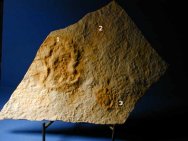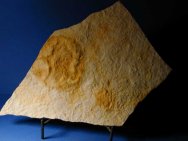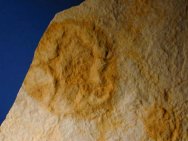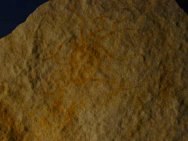Scyphozoan Jellyfish Ichnofossil
Phylum Cnidaria, Subphylum Medusozoa, Class Scyphozoa
Age: Middle Cambrian
Size (25.4 mm = 1 inch): Matrix: 12.8 by 8.5 inches maximum
Fossil Site: Blackberry Hill, Krukowski Quarry, Mount Simon Sandstone Outlier, Mosinee,Wisconsin
Code: DD424
Price: $375.00 - Sold
|
Two types of jellyfish fossils are found in the quarry, smaller tentacle jelly fish, which are rare in the quarry, and the larger medusa form of jellyfish. This particular specimen is from a new layer with the first such tentacle jellyfish to be recovered in three years. It is also the first layer to yield tentacle and madusoid forms in association, as is the case in this specimen. This flagstone plate contains two tentacle Scyphozoa, and a medusa measuring about 4 inches in diameter. It
comes from a particular horizon in the Mount Simon Sandstone formation
that also yields fascinating Diplichnites,
huge Jellyfish (Medusae)
and Climactichnites.
Jellyfish Being comprised entirely of soft tissue (living jellyfish are about 95 % water), unlike animals with exoskeletons (e.g., trilobites) or skeletons (vertebrates), jellyfish fossils are body fossils that are impressions of the jellyfish. Such fossil impressions are rare throughout the fossil record. Jellyfish were some of the most ferocious predators of the Cambrian marine environment. These fossils are almost surely the result of a mass stranding on an ancient Cambrian beach, possibly caused by a storm surge. Science believes jellyfish fossils may only result from being stsanded on a beach, and subsequent lack of predation and rapid burial by sediment or other material. At least during the Cambrian there were no purely land-based predators. Phylum Cnidaria (anemones, corals, jellyfish and sea pens) are among the most ancient animals and has one of the longest fossil histories of metazoans. Though simple in body form, they remain ubiquitous and widespread in modern marine environments. The earliest forms in the fossil record appear in Ediacarian fauna of Southern Australia, which dates to the Precambrian some 600 million years ago. Their persistence is clear testament that old and simple animals can be enormously successful, and that the clique' "climbing the evolutionary ladder" is a misnomer; rather, life either adapts to the current and changing environment, or perishes. |
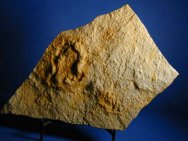
 body
fossils are incredibly subtle, and therefore this specimen has been
subtly stained.
body
fossils are incredibly subtle, and therefore this specimen has been
subtly stained.